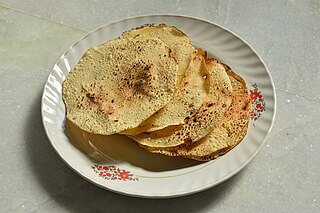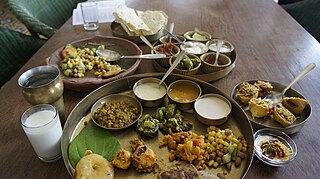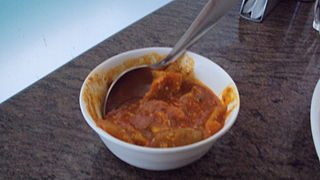
Idli or idly is a type of savoury rice cake, originating from South India, popular as a breakfast food in Southern India and in Sri Lanka. The cakes are made by steaming a batter consisting of fermented black lentils (de-husked) and rice. The fermentation process breaks down the starches so that they are more readily metabolised by the body.

Pakora is a fritter originating from the Indian subcontinent. They are sold by street vendors and served in restaurants in South Asia. It consists of items, often vegetables such as potatoes and onions, coated in seasoned gram flour batter and deep fried.

Raita is a side dish in Indian cuisine made of dahi together with raw or cooked vegetables, more seldom fruit, or in the case of boondi raita, with fried droplets of batter made from besan.

Chaat, or chāt is a family of savoury snacks that originated in India, typically served as an hors d'oeuvre or at roadside tracks from stalls or food carts across South Asia in India, Pakistan, Nepal and Bangladesh. With its origins in Uttar Pradesh, India, chaat has become immensely popular in the rest of South Asia.

A papadam, also known as a papad, is an Indian dough of black gram bean flour, either deep fried or cooked with dry heat until crunchy. Other flours made from lentils, chickpeas, rice, tapioca, millet or potato are also used. Papad is typically served as an accompaniment to a meal in India, Pakistan, Bangladesh, Nepal, Sri Lanka and the Caribbean or as an appetizer, often with a dip such as chutneys or toppings, such as chopped onions and chili peppers, or they may be used as an ingredient in curries.
Maharashtrian or Marathicuisine is the cuisine of the Marathi people from the Indian state of Maharashtra. It has distinctive attributes, while sharing much with other Indian cuisines. Traditionally, Maharashtrians have considered their food to be more austere than others.

Gujarati cuisine is the cuisine of the Indian state of Gujarat. The typical Gujarati thali consists of rotli, dal or curry, rice, and shaak. The thali will also include preparations made from pulses or whole beans such as moong, black eyed beans etc., a snack item (farsaan) like dhokla, pathra, samosa, fafda, etc. and a sweet (mishthaan) like mohanthal, jalebi, sevaiya etc.

South Asian pickle is a pickled food made from a variety of vegetables and fruits preserved in brine, vinegar, edible oils, and various South Asian spices. The pickles are popular across South Asia, with many regional variants, natively known as lonache, avalehikā, uppinakaayi, pachadi or noncha, achaar, athāṇu or athāṇo or athāna, khaṭāī or khaṭāin, sandhan or sendhan or sāṇdhāṇo, kasundi, or oorugaai.

Indian breads are a wide variety of flatbreads and crêpes which are an integral part of Indian cuisine. Their variation reflects the diversity of Indian culture and food habits.

Kachori is a sweet and spicy deep-fried snack, originating in India subcontinent, and common in places with Indian diaspora and other South Asian diaspora. Alternative names for the snack include kachauri, kachodi and katchuri.

Kadhi, or karhi, is a popular dish mainly consumed in South Asia. It consists of a thick gravy or soup based on gram flour, and it may contain vegetable fritters called pakora, which include dahi (yogurt) for a sour taste. It is often eaten with cooked rice or roti. Varieties of kadhi include those from Rajasthan, Maharashtra, Gujarat, Punjab, and Sindh, all of which are located in present-day India and Pakistan.
Bhojpuri cuisine is a style of food preparation common among the Bhojpuri people of Bihar and eastern Uttar Pradesh in India, and also the Terai region of Nepal. Bhojpuri foods are mostly mild and tend to be less hot in terms of spices used. The cuisine consists of both vegetable and meat dishes.

Ghugni or ghuguni or guguni is a curry made of peas or chickpeas. Different variations of the dish use different types of peas or chickpeas, such as black gram, green peas, or white peas. It is a snack native to the Indian subcontinent, especially popular in Eastern India, Northeast India and in Bangladesh.

Manipuri cuisine refers to the cuisine of Manipur, a state of northeastern India. Daily meals are based on rice, with a few side dishes of vegetables, fish and meat. A meal would usually have a vegetable stew called ensaang or athongba, flavored with dried or fried fish; stir-fried vegetables called kanghou; and a spicy item, which could be morok metpa, eromba, or singju. All piquant side dishes are accompanied by a choice of fresh herbs, collectively called maroi. The base and essence of Meitei cuisine is the fermented fish called ngari. Several dishes of meat, mostly chicken and pork, are cooked with unique recipes. As a result of religious taboos, however, the Meitei Pangals do not cook the latter.

Andhra cuisine, culturally known as Telugu cuisine, is a cuisine of India native to the state of Andhra Pradesh. It is generally known for its tangy, hot, and spicy taste.

Malaysian Indian cuisine, or the cooking of the ethnic Indian communities in Malaysia, consists of adaptations of authentic dishes from India, as well as original creations inspired by the diverse food culture of Malaysia. Because the vast majority of Malaysia's Indian community are of South Indian descent, and are mostly ethnic Tamils who are descendants of immigrants from a historical region which consists of the modern Indian state of Tamil Nadu and Sri Lanka's Northern Province, much of Malaysian Indian cuisine is predominantly South Indian inspired in character and taste. A typical Malaysian Indian dish is likely to be redolent with curry leaves, whole and powdered spice, and contains fresh coconut in various forms. Ghee is still widely used for cooking, although vegetable oils and refined palm oils are now commonplace in home kitchens. Before a meal it is customary to wash hands as cutlery is often not used while eating, with the exception of a serving spoon for each respective dish.

Handvo is a savory vegetable cake originating from Gujarat, India. It is a part of the Gujarati cuisine. It is often made with a bottle gourd filling, though many other vegetables can be added. Sometimes crushed peanuts are also added.

In Indian cuisine, dal, paruppu or pappu, are dried, split pulses that do not require soaking before cooking. India is the largest producer of pulses in the world. The term is also used for various soups prepared from these pulses. These pulses are among the most important staple foods in South Asian countries, and form an important part of the cuisines of the Indian subcontinent.

Vada or Vadai is a category of savoury fried snacks native to India. Vadas can be described variously as fritters, cutlets, or dumplings. Alternative names for this food include vadai, vade, and bada. Vadas are sometimes stuffed with vegetables and traditionally served with chutneys and sambar.
























